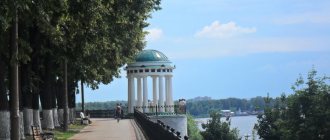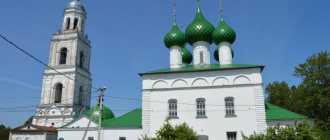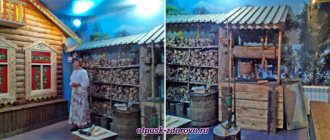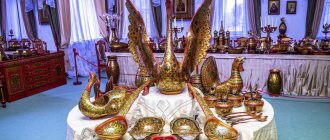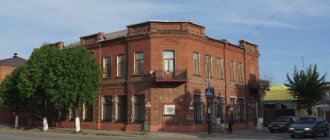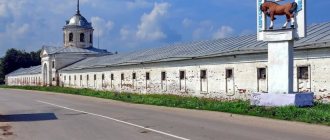Gavrilov-Yam: what to see in 1 day
A trip to Gavrilov-Yam should begin with the most popular attractions that have made this town famous throughout the Yaroslavl region. You can visit them in one day.
Coachman Museum
- Address: Sovetskaya street, 2.
The only Coachman Museum in Russia opened in Gavrilov-Yam in 2005. It is a complex of two buildings made in the ancient style.
In each of the houses there is an exhibition of household items that coachmen who lived in the 19th century used every day. Here you can see wooden arches, bells, sleighs, harnesses, whips and simple household utensils.
The excursion program is enlivened by the guide's stories, quizzes and unusual facts from the life of coachmen. On holidays, feasts are held with delicious pies, tea and dancing. Musical accompaniment will be provided by balalaika and accordion players.
Interesting fact: there is a legend that Gavrilov-Yam got its name in honor of the coachman Gavrila, who lived here in the middle of the 16th century.
Museum of the Lokalov merchants
- Address: Sovetskaya street, 1.
The name of Alexey Vasilyevich Lokalov is often found in Gavrilov-Yam. At the end of the 19th century, this merchant made a huge contribution to the development of the city: he built a manufacturing plant, opened schools and almshouses.
In 2015, a museum was founded in Gavrilov-Yam, named after Alexey Lokalov. The exhibition dedicated to the life of merchants and peasants was housed in the building of the former parish school, which was built by Lokalov himself.
The wooden building in the style of Russian architecture was restored and brought into decent shape. Carved columns, patterned inserts and elegant platbands are full of fresh colors
The exhibition is located in several halls, each of which is dedicated to a specific topic. There is an exhibition of samples of fabrics and linen products produced at the Lokalova factory. The exhibition “Factory Worker’s Closet” relates to the same theme. It recreates the interior of the room of an ordinary employee of a textile factory.
No less interesting is the exhibition dedicated to St. Nicholas Church. In the 19th century, this church was the center of the spiritual life of the city, and is now recognized as a historical and architectural monument. The museum archives contain old photographs and documents that shed light on the centuries-old history of the temple.
At the end of the excursion program, tourists are treated to excellent English tea. The tradition of tea drinking is connected with the fact that British engineers often visited the Lokalov factory, and as a hospitable host, Alexey Vasilyevich invited them to the table.
Church of St. Nicholas the Wonderworker
- Address: Krasnoarmeyskaya st., 2.
St. Nicholas Church was erected in 1798 at the expense of parishioners. The brick building is made in Baroque style. It is decorated with figured sandriks, rectangular and rounded drums with domes, as well as a decorative dormer window. The bell tower is made in the same style. At the end of the 19th century, the building was restored at the expense of the merchant Lokalov.
St. Nicholas Church operated until the 1930s. During Soviet times, its premises housed a sports club, which existed until 1991, when the church was returned to the believers. Currently, the ancient temple operates and is protected as a monument of historical and architectural heritage.
origin of name
It is believed that the village got its name from the coachman Gavrila. In any case, the first part of the city's name is undoubtedly connected with the male name Gavrila
.
Origin of the name Yam
has several versions.
According to one, almost official, there was once a station here on the postal route, where racing pit horses were kept. According to another version, the name is due to the fact that the settlement is located in a lower place in relation to the surrounding territory. The third version of the origin, the least plausible, but the most poetic, K: Wikipedia: Articles without sources (type: not specified) [ source not specified 2494 days
] states that “in the languages of the peoples who inhabited this corner of Russia, the word
Yam
had several meanings , including beauty, landscape, picturesque place”; this meaning of the word actually exists in the Tatar and Mari languages.
The most interesting museums in Gavrilov-Yam
Museums are the “calling card” of the city of Gavrilov-Yam. There are many different exhibitions and displays dedicated to history, culture and ancient crafts. It will be interesting to visit them for both adults and children.
Museum of Peasant Life “Marya the Mistress”
- Address: st. Chapaeva, 5.
In everyday life, this museum is affectionately called “Maryushka”. Its founder, Nina Fedorovna Brondikova, is a native resident of Gavrilov-Yam.
All her life she collected antiques, which later became the basis for the creation of the Museum of Peasant Life. The peculiarity of the exhibition is that most of the ancient exhibits are still in working order. For example, you can still weave on a loom, but you can still spin on a spindle.
The tour is conducted by girls dressed in Russian folk costumes. They will not only tell you, but also show you how certain objects were used in ancient times. Another nice feature of the museum is that you can hold all the exhibits in your hands and even try to work on them.
The museum occupies a building stylized as a Russian hut. It is decorated with architraves, cornices and pilasters with intricate handmade carvings.
Velikoselsky Museum of Local Lore
- Address: st. Trufanova, 13, p. Great.
A few kilometers from Gavrilov-Yam is the village of Velikoye, where there is also something to see. One of its main attractions is the Local History Museum. The village of Velikoye was founded at the beginning of the 13th century, which makes it one of the oldest settlements in the Yaroslavl region.
An extensive exhibition tells about the most striking events from the history of the village. Much attention is paid to two battles that took place in its vicinity:
- the battle of Russian soldiers with the Mongol-Tatar army in 1392;
- the battle of the Grand Duke of Moscow Vasily the Dark with the Galician prince Vasily Kosy in 1435.
The museum collection includes more than a thousand exhibits dating from different eras. Here you can see ancient handwritten books, archaeological artifacts, ancient coins, paintings and documents. In several halls, the interiors of peasant huts and noble chambers are also recreated.
Potato Riot Museum
- Address: st. Trufanova, 22, Velikoye village.
In the village of Velikoy there is the only museum in Russia entirely dedicated to the topic of potatoes. In the first half of the 19th century, Emperor Nicholas I strongly recommended that villagers begin to grow this vegetable in their fields.
The peasants did not want to develop a new agricultural crop, which is why the so-called “potato riots” swept across the country. Meanwhile, Efim Karnovich lived in the village of Velikoy, who, unlike his compatriots, supported the emperor’s decree and began large-scale potato cultivation.
The museum's exhibition is dedicated to this story. During the excursion, tourists are introduced to ancient equipment with which starch was made and potato dishes were prepared in the century before last.
Anyone can try out an old potato masher, mortar and other equipment. On the ground floor of the museum there is a “Potato Cafe”, where you can dine on potato pancakes, potato pancakes and shangs prepared according to traditional recipes.
School Museum "Svetelka"
- Address: Nekrasovskaya st., 1, Velikoye village.
The museum is located in the Velikiye Selo school and is a room stylized as a merchant's hut. Furniture items and textile decorations were made by the hands of schoolchildren and schoolgirls during labor lessons.
Young masters and craftswomen act as tour guides. They not only talk about how merchant families lived in the village of Velikoye, but also conduct master classes in embroidery, knitting, burning and carpentry.
The interactive tour program around the original attraction also includes performances during which the tourist becomes a participant in a wedding ceremony, baptism, chant or celebration.
Pottery workshop “Gardens of Aurica”
- Address: st. Radishcheva, 20.
“Gardens of Aurica” is a network pottery production company with branches throughout the country. The branch, located in Gavrilov-Yam, has not so much a production, but a museum character.
Guests have the opportunity to watch the creation of clay products and try themselves as a potter, visit the production workshop, an exhibition of finished products and a store where you can purchase original dishes as a souvenir for yourself or a gift for loved ones.
Themed holidays
On June 12, a coachman song festival is held in Gavrilov-Yam. The festival won the national Russian Event Awards (2014). The national award “Russian Event Awards” was established as an industry award, awarded based on the results of a competition of projects for achievements in the development of the event tourism industry.
In August, the Regional Festival of Folk Arts and Crafts “Souvenir of the Coachman’s Country” is held. At the festival you can not only see, but also purchase folk art products, learn many types of crafts on your own: wood carving, wicker weaving, blacksmithing, ceramics, hand weaving, wool felting, test plastic, the art of making burl products, patchwork dolls and much more. to another. As part of the festival “Souvenir of the Coachman's Country”, a competition is held for the best master class in folk arts and crafts with monetary incentives for participants. The main character of the festival is the fairytale horse - Gaius Julius Caesar. He is the one who gives gifts and prizes to the participants.
Cultural recreation in Gavrilov-Yam and entertainment
During a city tour, it is worth visiting cultural institutions where you can have a good time watching interesting theater performances or playing sports.
House of Culture
- Address: Club street, 1.
At the beginning of the 20th century, the stone building in the classicist style served as an almshouse for single women workers at the flax mill. Today it houses a recreation center where creative competitions, theatrical performances, business and social and educational meetings are held.
The entertainment program of the establishment includes choral singing concerts, choreographic performances, master classes in decorative and applied arts, exhibitions of paintings and photographs.
The House of Culture is also visited by circus troupes, musicians, pop and opera singers from different parts of the country. Their concerts and performances attract special attention from citizens and tourists who come to Gavrilov-Yam.
Cinema hall at the House of Culture
- Address: Club street, 1.
In 2022, the House of Culture underwent a large-scale renovation, and at the same time, a modern 3D cinema with excellent technical and acoustic equipment was installed. New Russian and foreign cinema, animated cartoons for children of all ages appear weekly on the cinema screens.
Palace of Children's Creativity
- Address: Sovetskaya st., 2.
The Palace of Children's Creativity hosts clubs and sections in arts and crafts, pop singing, ballet, drawing and theater arts, which can be especially interesting for children.
Creative associations regularly organize concerts and special events dedicated to the celebration of the New Year, Victory Day, Maslenitsa, etc. In the summer, festivals and open-air concerts are organized. The entertainment program is always complemented by animation, competitions, games and sports competitions.
The Palace building was built at the beginning of the 20th century in the style of pseudo-realism. It contained living rooms belonging to the manager of the manufacturing factory, as well as work rooms for concluding transactions.
Sports stadium "Trud"
- Address: corner of Pionerskaya and Sportivnaya streets.
The city stadium is the oldest sports facility in the Yaroslavl region. It was founded in 1912 by English specialists who worked at the Lokalova textile factory.
Currently, the stadium infrastructure includes:
- a huge football field with wooden goals;
- five sectors of wooden stands
- gastronomic area, including a retro cafe and an eco-cafe;
- playing fields for croquet, rounders and towns;
- showers;
- ecological grove.
Estate of A.A. Lokalova
- Address: Yaroslavskaya st., 14, Velikoye village.
In the 1880s, the heir of the merchant Lokalov, Alexander Alekseevich, decided to build an estate in his native village of Velikoy. The architect he hired, Fyodor Shekhtel, created a true masterpiece in the pseudo-Russian style.
The two-story building, designed in the form of a tower, was distinguished by an abundance of decor. The first floor was decorated with diamond rustication, the second was decorated with flies with bright tiles, semi-columns and stained glass windows. A special touch to the architectural appearance was added by a hipped tower with a weather vane, located above the main entrance.
Construction of the mansion was completed in 1890. Its proud owner, Alexander Alekseevich Lokalov, died a year after the housewarming, and did not really have time to live in his house. After Lokalov’s death, the mansion was inherited by his daughters, who used the house as a country house.
In 1917, the estate was seized from the Lokalov family and nationalized. During the Soviet years, it housed a museum of noble life, later a youth club, and during the war, the premises were occupied by a shelter for children whose parents died in Besieged Leningrad.
Today, the former estate is an orphanage. In the interior, decorative elements of the 19th century have been preserved: stucco, oak carving, frescoes. Overall, the building is in disrepair and in dire need of repair.
Gavrilov-Yamsky Flax Mill
- Address: ave. Stroiteley, 6A.
The Gavrilov-Yamsky flax mill was created by Alexey Lokalov in the 1870s. The opening of the manufacturing factory contributed to the rapid development of the city.
Today, the surviving factory buildings are recognized as monuments of historical, cultural and architectural heritage.
A complex of workers' buildings built at the beginning of the last century has survived to this day. These are two- and three-story brick buildings in the classicist style.
Work closets
- Address: Pirogova street, 6.
Another element of factory development that has survived to this day is a complex of residential buildings, or “closets,” where factory employees lived. The complex consists of several brick buildings. Since the prosperity of the flax mill, these buildings have remained virtually untouched.
People's House building
- Address: Club street, 8.
The elegant building in the classicist style was built at the end of the 19th century. The unique structure attracts attention due to a number of snow-white columns with capitals and an attic decorated with a niche with a dormer window.
The ancient building is in excellent condition. Now it houses the police department and the prosecutor's office. The former people's house is recognized as a monument of historical and cultural heritage of federal significance.
Temples and churches in Gavrilov-Yam
In Gavrilov-Yam and its surroundings there are unique temple complexes, with which the history of local settlements and their spiritual life are firmly connected.
Velikoselsky Kremlin
- Address: Gavrilov-Yamsky district, Velikoye village.
The complex of religious buildings, codenamed “Kremlin,” is located in the center of the village of Velikoye. The basis for the creation of the Kremlin was the Church of the Nativity of the Virgin Mary, founded by Anikita Repnin in 1709. The temple was dedicated to the Battle of Poltava, making it the first monument to this historical event.
The Church of the Nativity of the Virgin Mary was built of brick by Velikiye Selo craftsmen. The building has a quadrangle shape and is topped with five domes with dark green domes. Nearby stands a bell tower in the style of Russian architecture.
Later, the Church of the Intercession of the Virgin Mary was built on the territory of the Kremlin. The building's style resembles an architectural monument of the 17th century. It has the shape of a parallelepiped with a three-chamber apse adjacent to the east.
The temple is crowned with five domes: four light ones (azure with stars) and a massive gilded dome in the center. Some decorative elements have survived to this day, for example, artistic tiles, stucco molding and frescoes.
During the Soviet years, the Kremlin was built to house warehouses and rural clubs. During this time, many valuable icons and expensive church utensils were lost. The temples reopened in the early 2000s. The restoration returned the buildings to their former appearance and stopped natural destruction. Today both churches are active and in excellent condition.
Church of the Bogolyubskaya Icon of the Mother of God
- Address: Proletarskaya st., 32, Velikoye village.
The Bogolyubskaya Church was built in the village of Velikoy in 1846. It is made of brick in the style of classicism. The main mass of the building is crowned by a heavy drum with a helmet-shaped dome and a crown at the end. A two-tier bell tower rises nearby.
The church was closed in the 1930s and resumed religious activities in the 1990s. During the restoration, the roofing and bells were replaced. Decorations also appeared in the form of niches with frescoes depicting biblical scenes.
There is a cemetery on the territory of the church. Funeral ceremonies and memorial services are held in the temple.
Chapel of Gabriel the Archangel
- Address: Sovetskaya street.
The brick chapel, consecrated in honor of the Archangel Gabriel, was built in 2005. This is a small rectangular building with expressive window niches and a polygonal dome with a gilded dome on top. In 2015, the chapel was expanded, making it accessible to public visits.
Economy
As of 2013, the machine-building plant and the Gavrilov-Yamsky flax mill are city-forming enterprises that provide employment to the majority of the city's population.
In the early 2000s, it was planned to move the weaving production of the Moscow Trekhgornaya Manufactory factory to the city.
The Gavrilov-Yamsky flax mill traces its history back to the Lokalov textile manufactory. The plant carries out the full technological chain of flax processing - from flax carding production to the production of finished products (linen and mixed fabrics, patterned tablecloths, napkins, towels, etc.). The plant is the only production facility in the country that produces canvas for painting.
In July 2013, the Gavrilov-Yamsky Flax Mill was declared bankrupt.
JSC GMZ "Agat" produces modern units for military aircraft engines, produces and repairs fuel control equipment for aircraft, hydraulic equipment for mobile lifting equipment, road construction, municipal machines and manipulators, spare parts for cars, as well as consumer goods: children's strollers, luggage trolleys, sales tents, folding tables and chairs, shelving, deck chairs, folding beds. The assembly of walk-behind tractors has been established.
The category of large and medium-sized industrial enterprises also includes:
- State Unitary Enterprise (SUE) “Gavrilov-Yamsky Bakery” (bakery and confectionery products);
- State Unitary Enterprise "Gavrilov-Yamskaya Printing House" (printing industry).
- Closed Joint Stock Company (CJSC) Gavrilov-Yamsky "Agropromtekhsnab" (mechanical engineering and metalworking);
- CJSC "Paints and varnishes" (production of paints and enamels).
The city is developing tourism. Since the end of 2001, the Gavrilov-Yamsky municipal district has been included in the program of tourist routes. The new tourist route “Gavrilov-Yam - Velikoye village” is included in the Golden Ring of Russia. The area is visited by an average of 1,600 tourists per year.
Sculptural compositions and monuments of the city
The sculptural compositions in Gavrilov-Yam are of a historical and memorial nature.
Monument to the Soldier-Liberator
- Address: Patova street.
The impressive memorial complex is located on Sovetskaya Square. In its center is a bronze statue of a liberator warrior, at the foot of which the Eternal Flame blazes. On both sides of the monument there are black granite slabs with the names of the heroes who fell during the liberation of Gavrilov-Yam.
Monument “Eternal glory to the students and teachers of school No. 1”
- Address: Yubileiny proezd.
On the territory of school No. 1 there is a white stone monument dedicated to the students and teachers who died during the Great Patriotic War. The monument is a stele with a high relief of a soldier in an overcoat and helmet.
On the granite base of the monument there are memorial plaques with the names of the fallen heroes. Every year, ceremonial events of a military-patriotic nature are held on the site in front of the monument.
Memorial complex "To the soldiers of the Soviet army who died of wounds in hospitals"
- Address: Vostochnaya street.
The memorial is located in the city cemetery, at the site of the mass burial of soldiers whose lives were cut short in Gavrilov-Yam hospitals. The monument consists of two steles with memorial plaques and a replica of a Red Army helmet.
Monument to V.I. Lenin
- Address: Sovetskaya Square.
Monument to V.I. Lenin (popularly nicknamed “Lenin’s head”) is located in the central square. A stone bust of the revolutionary stands on a red granite pedestal. Around the memorial there is a small recreation area equipped with benches and decorated with flower beds.
MiG-23 fighter
- Address: Mashinostroiteley proezd.
In 2005, in honor of the 60th anniversary of the Great Victory, a monument to the Soviet supersonic fighter MiG-23 was unveiled. The memorial was installed opposite, which specializes in creating a variety of equipment for civil and military aviation.
Walking outdoors
In addition to crowded squares and gardens, in Gavrilov-Yam and the surrounding area there are several picturesque corners of nature where tourists can enjoy the fresh air and beautiful views.
Black Pond
- Coordinates on the map: 57.347592, 39.768597.
Black Pond is located in the village of Velikoy. This is the largest artificial reservoir in the region, created before the construction of dams. The pond receives its nutrition from underground springs and melt water. In 1985 it was given the status of a natural monument.
The name of the pond is rooted in the ancient history of the village of Velikoye. In the old days, there were forges on its banks, and the water acquired a dark hue due to coal dust. There is also a version that the reservoir received its name because of the characteristic dark silt, which makes the bottom and water appear black.
Today, the Black Pond is a popular fishing spot, and in the winter it is covered with solid ice, which is why a public skating rink opens here.
City pond
- GPS coordinates: 57.309043, 39.847909.
In the center of Gavrilov-Yam there is an artificial reservoir. Due to the lush underwater vegetation, it is unsuitable for swimming, but is suitable for fishing. It is home to perches and carp.
In 2014, the city organized public works to improve the banks of the pond.
Volunteers cleared the water of mud and debris, planted young trees, and installed homemade benches. As a result, the city pond has become a pleasant and popular place for family recreation in nature.
Story
The first written mention of the village “Vora, Gavrilovo also”
, located 7 km from the Rostov-Suzdal tract, dates back to 1545. Mentioned in the lists of the Trinity-Sergius-Varnitsa Monastery, to which it belonged at that time. At that moment, the village consisted of only 7 households.
During the 16th-18th centuries, the village changed its name and status several times: the village of Gavrilovsky Yam
(decree of 1580 on behalf of Tsar Ivan the Terrible),
Gavrilov-Yamskaya Sloboda
, village of
Gavrilov-Yam
(after the construction of the church at the end of the 18th century).
In the early 1870s, local merchant Alexey Vasilyevich Lokalov from the village of Velikoye opened a textile manufactory in the village, which ensured the rapid growth of the small village at that time.
On August 5, 1922, the Presidium of the Yaroslavl Provincial Executive Committee assigned Gavrilov-Yam the status of an urban-type settlement. Already a decade and a half later, on December 26, 1938, by the Decree of the Presidium of the Supreme Soviet of the RSFSR, the working village of Gavrilov-Yam was transformed into the city of Gavrilov-Yam.
In 1968, a machine-building plant was opened in the city - a facility of defense significance, formed on the basis of a subsidiary of the Moscow Mechanical Plant.

